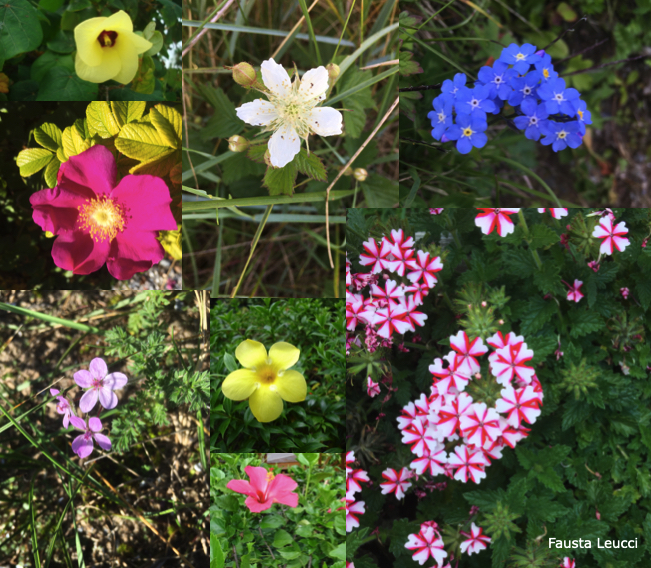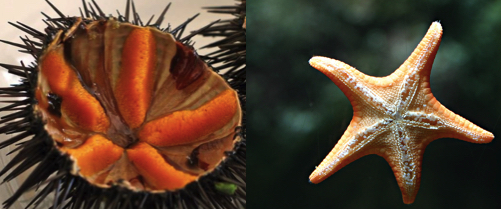
NATURE AND ITS SHAPES
"The image of man and woman arises from the divine proportion. In my opinion, the propagation of plants and the progenitive acts of animals are in the same proportion"
Johannes Kepler
The golden ratio, which has always been considered an index of beauty and harmony, is recognizable in many laws of nature which demonstrate its biological origin. It has been observed, for example, that the number of petals, in many species of flowers, is a number belonging to the Fibonacci sequence (5, 13, 55, 377). In it, the ratio between two consecutive terms better and better approximates the golden number φ ~ 1.618... which the ancient Greeks, convinced of the geometric harmony of the Universe, called "Divine Proportion". The figure below shows different types of 5-petal flowers:

The number five and the pentagram, which the Pythagoreans considered a "mystical symbol of perfection", are also found in the animal world, in particular among the echinoderms, such as the starfish and the sea urchin:

SPIRALS IN NATURE
"Nature loves logarithmic spirals: from sunflowers to seashells, from vortexes to hurricanes to immense galactic spirals, it seems that nature has chosen this harmonious figure as its favorite ornament"
Mario Livio
In addition to the pentagram, one of the most harmonious shapes present in nature is the spiral shape, connected to the golden number φ and to the Fibonacci sequence. In particular, many animals, plants, flowers and fruits have characteristics that recall those of the golden spiral, that is a logarithmic spiral whose constant ratio between consecutive radii is equal to the golden number φ and, with good approximation, it can be obtained using the numbers of the Fibonacci sequence.
The table shows some examples of spiral shapes present in the animal world and in the vegetable world:
|
THE SPIRAL IN THE ANIMAL WORLD |
The shell of the Nautilus, a mollusc belonging to the cephalopod class, is one of the most beautiful examples of a golden spiral that the nature offers. The presence of the golden ratio can be recognized in the structure of this shell. In fact, during growth, the shell of the Nautilus enlarges, maintaining the same proportions and reproducing successive arcs, which represent those of a golden spiral. In particular, the ratio between the radii of two consecutive coils of the mollusc shell is equal to the ratio between two consecutive terms of the Fibonacci sequence:
Also in the shells of gastropods, such as snails, it is possible to find a spiral growth:
The same principle of growth of the gastropods shells is also found in mammals; in particular:
Furthermore, the chameleon's tail and the seahorse's tail grow like a perfect logarithmic spiral:
Even the peregrine falcon, during the hunt, before pounced on its prey, follows a spiral trajectory:
|
|
THE SPIRAL IN THE PLANT WORLD |
Phyllotaxis (branch of botany which, in the process of plant formation, studies the positioning of leaves and homologous plant organs) demonstrates how, in some species of plants, the distribution of leaves follows the shape of a logarithmic spiral. The same is true for the petals of some flowers and the seeds of some fruits. In 1875, the German botanist Julius von Wiesner (1838 - 1916) hypothesized that the growth of branches, leaves and seeds, in plant species, took place in a way that the absorption of light was optimal, namely avoiding the presence of shadows. This explained the spiral growth of leaves along the stems of some plants. The first to intuit the existence of a possible connection between phyllotaxis and the Fibonacci sequence was the German astronomer, astrologer, mathematician, cosmologist, music theorist, natural philosopher and Lutheran theologian, Johannes Kepler (1571 – 1630). Kepler's intuition found confirmation only in the 19th century, after a series of observations made by some botanists. In 1837, the French brothers Auguste and Louis Bravais confirmed the general rule connecting the proportions of the spirals, associated with phyllotaxis, with the Fibonacci sequence.
Other examples of spirals, which can be found in nature and which follow the Fibonacci sequence, are:
|